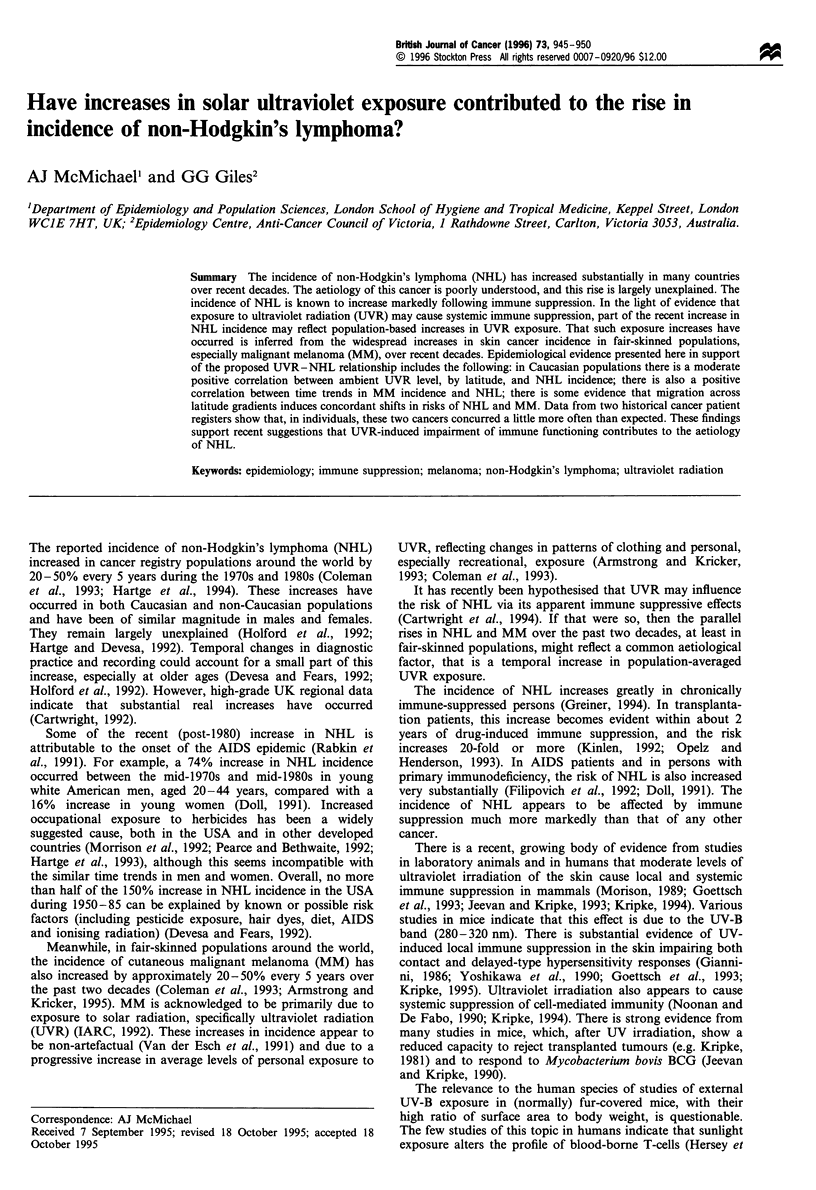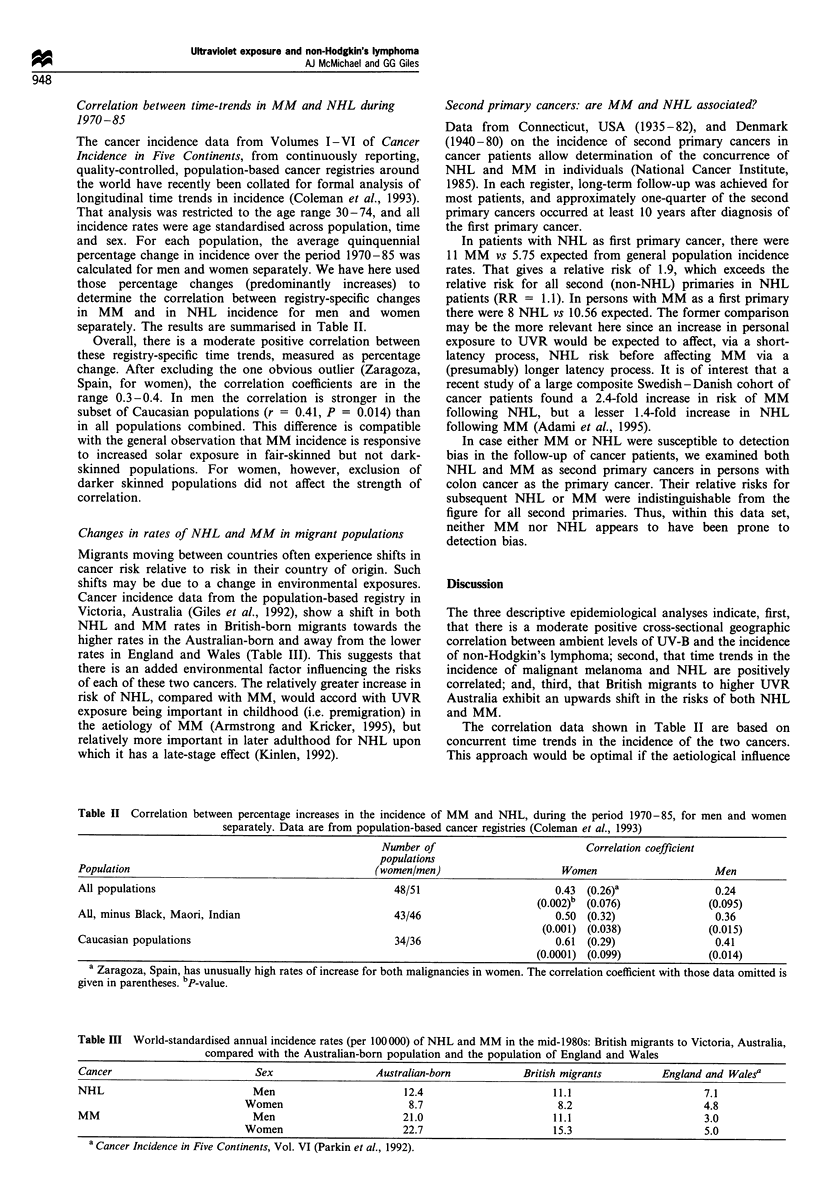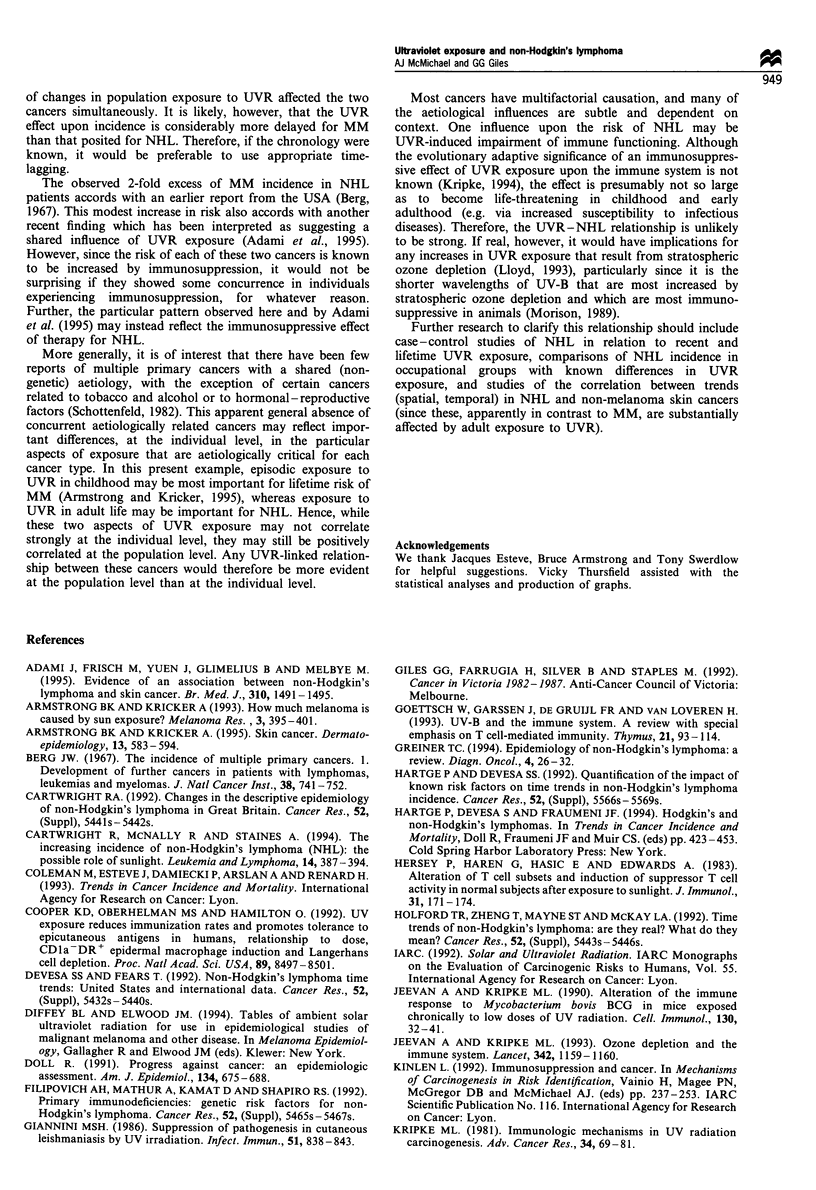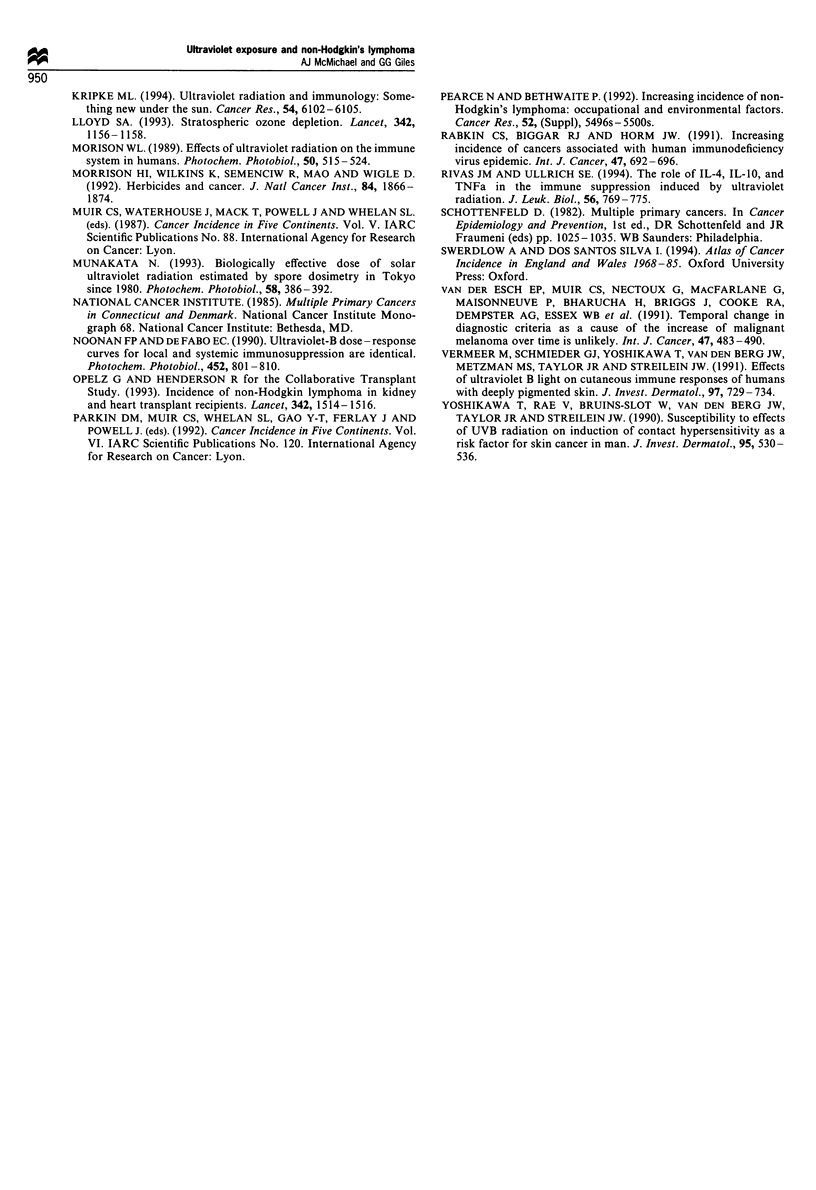Abstract
The incidence of non-Hodgkin's lymphoma (NHL) has increased substantially in many countries over recent decades. The aetiology of this cancer is poorly understood, and this rise is largely unexplained. The incidence of NHL is known to increase markedly following immune suppression. In the light of evidence that exposure to ultraviolet radiation (UVR) may cause systemic immune suppression, part of the recent increase in NHL incidence may reflect population-based increases in UVR exposure. That such exposure increases have occurred is inferred from the widespread increases in skin cancer incidence in fair-skinned populations, especially malignant melanoma (MM), over recent decades. Epidemiological evidence presented here in support of the proposed UVR-NHL relationship includes the following: in Caucasian populations there is a moderate positive correlation between ambient UVR level, by latitude, and NHL incidence; there is also a positive correlation between time trends in MM incidence and NHL; there is some evidence that migration across latitude gradients induces concordant shifts in risks of NHL and MM. Data from two historical cancer patient registers show that, in individuals, these two cancers concurred a little more often than expected. These findings support recent suggestions that UVR-induced impairment of immune functioning contributes to the aetiology of NHL.
Full text
PDF





Selected References
These references are in PubMed. This may not be the complete list of references from this article.
- Adami J., Frisch M., Yuen J., Glimelius B., Melbye M. Evidence of an association between non-Hodgkin's lymphoma and skin cancer. BMJ. 1995 Jun 10;310(6993):1491–1495. doi: 10.1136/bmj.310.6993.1491. [DOI] [PMC free article] [PubMed] [Google Scholar]
- Armstrong B. K., Kricker A. How much melanoma is caused by sun exposure? Melanoma Res. 1993 Dec;3(6):395–401. doi: 10.1097/00008390-199311000-00002. [DOI] [PubMed] [Google Scholar]
- Armstrong B. K., Kricker A. Skin cancer. Dermatol Clin. 1995 Jul;13(3):583–594. [PubMed] [Google Scholar]
- Berg J. W. The incidence of multiple primary cancers. I. Development of further cancers in patients with lymphomas, leukemias, and myeloma. J Natl Cancer Inst. 1967 May;38(5):741–752. [PubMed] [Google Scholar]
- Cartwright R. A. Changes in the descriptive epidemiology of non-Hodgkin's lymphoma in Great Britain? Cancer Res. 1992 Oct 1;52(19 Suppl):5441s–5442s. [PubMed] [Google Scholar]
- Cartwright R., McNally R., Staines A. The increasing incidence of non-Hodgkin's lymphoma (NHL): the possible role of sunlight. Leuk Lymphoma. 1994 Aug;14(5-6):387–394. doi: 10.3109/10428199409049694. [DOI] [PubMed] [Google Scholar]
- Cooper K. D., Oberhelman L., Hamilton T. A., Baadsgaard O., Terhune M., LeVee G., Anderson T., Koren H. UV exposure reduces immunization rates and promotes tolerance to epicutaneous antigens in humans: relationship to dose, CD1a-DR+ epidermal macrophage induction, and Langerhans cell depletion. Proc Natl Acad Sci U S A. 1992 Sep 15;89(18):8497–8501. doi: 10.1073/pnas.89.18.8497. [DOI] [PMC free article] [PubMed] [Google Scholar]
- Devesa S. S., Fears T. Non-Hodgkin's lymphoma time trends: United States and international data. Cancer Res. 1992 Oct 1;52(19 Suppl):5432s–5440s. [PubMed] [Google Scholar]
- Doll R. Progress against cancer: an epidemiologic assessment. The 1991 John C. Cassel Memorial Lecture. Am J Epidemiol. 1991 Oct 1;134(7):675–688. doi: 10.1093/oxfordjournals.aje.a116143. [DOI] [PubMed] [Google Scholar]
- Filipovich A. H., Mathur A., Kamat D., Shapiro R. S. Primary immunodeficiencies: genetic risk factors for lymphoma. Cancer Res. 1992 Oct 1;52(19 Suppl):5465s–5467s. [PubMed] [Google Scholar]
- Giannini M. S. Suppression of pathogenesis in cutaneous leishmaniasis by UV irradiation. Infect Immun. 1986 Mar;51(3):838–843. doi: 10.1128/iai.51.3.838-843.1986. [DOI] [PMC free article] [PubMed] [Google Scholar]
- Goettsch W., Garssen J., de Gruijl F. R., van Loveren H. UV-B and the immune system. A review with special emphasis on T cell-mediated immunity. Thymus. 1993 Mar;21(2):93–114. [PubMed] [Google Scholar]
- Hartge P., Devesa S. S., Fraumeni J. F., Jr Hodgkin's and non-Hodgkin's lymphomas. Cancer Surv. 1994;19-20:423–453. [PubMed] [Google Scholar]
- Hartge P., Devesa S. S. Quantification of the impact of known risk factors on time trends in non-Hodgkin's lymphoma incidence. Cancer Res. 1992 Oct 1;52(19 Suppl):5566s–5569s. [PubMed] [Google Scholar]
- Hersey P., Haran G., Hasic E., Edwards A. Alteration of T cell subsets and induction of suppressor T cell activity in normal subjects after exposure to sunlight. J Immunol. 1983 Jul;131(1):171–174. [PubMed] [Google Scholar]
- Holford T. R., Zheng T., Mayne S. T., McKay L. A. Time trends of non-Hodgkin's lymphoma: are they real? What do they mean? Cancer Res. 1992 Oct 1;52(19 Suppl):5443s–5446s. [PubMed] [Google Scholar]
- Jeevan A., Kripke M. L. Alteration of the immune response to Mycobacterium bovis BCG in mice exposed chronically to low doses of UV radiation. Cell Immunol. 1990 Oct 1;130(1):32–41. doi: 10.1016/0008-8749(90)90159-o. [DOI] [PubMed] [Google Scholar]
- Jeevan A., Kripke M. L. Ozone depletion and the immune system. Lancet. 1993 Nov 6;342(8880):1159–1160. doi: 10.1016/0140-6736(93)92131-c. [DOI] [PubMed] [Google Scholar]
- Kripke M. L. Ultraviolet radiation and immunology: something new under the sun--presidential address. Cancer Res. 1994 Dec 1;54(23):6102–6105. [PubMed] [Google Scholar]
- Lloyd S. A. Stratospheric ozone depletion. Lancet. 1993 Nov 6;342(8880):1156–1158. doi: 10.1016/0140-6736(93)92130-l. [DOI] [PubMed] [Google Scholar]
- Morison W. L. Effects of ultraviolet radiation on the immune system in humans. Photochem Photobiol. 1989 Oct;50(4):515–524. doi: 10.1111/j.1751-1097.1989.tb05557.x. [DOI] [PubMed] [Google Scholar]
- Morrison H. I., Wilkins K., Semenciw R., Mao Y., Wigle D. Herbicides and cancer. J Natl Cancer Inst. 1992 Dec 16;84(24):1866–1874. doi: 10.1093/jnci/84.24.1866. [DOI] [PubMed] [Google Scholar]
- Munakata N. Biologically effective dose of solar ultraviolet radiation estimated by spore dosimetry in Tokyo since 1980. Photochem Photobiol. 1993 Sep;58(3):386–392. doi: 10.1111/j.1751-1097.1993.tb09579.x. [DOI] [PubMed] [Google Scholar]
- Noonan F. P., De Fabo E. C. Ultraviolet-B dose-response curves for local and systemic immunosuppression are identical. Photochem Photobiol. 1990 Oct;52(4):801–810. doi: 10.1111/j.1751-1097.1990.tb08685.x. [DOI] [PubMed] [Google Scholar]
- Opelz G., Henderson R. Incidence of non-Hodgkin lymphoma in kidney and heart transplant recipients. Lancet. 1993 Dec 18;342(8886-8887):1514–1516. doi: 10.1016/s0140-6736(05)80084-4. [DOI] [PubMed] [Google Scholar]
- Pearce N., Bethwaite P. Increasing incidence of non-Hodgkin's lymphoma: occupational and environmental factors. Cancer Res. 1992 Oct 1;52(19 Suppl):5496s–5500s. [PubMed] [Google Scholar]
- Rabkin C. S., Biggar R. J., Horm J. W. Increasing incidence of cancers associated with the human immunodeficiency virus epidemic. Int J Cancer. 1991 Mar 12;47(5):692–696. doi: 10.1002/ijc.2910470511. [DOI] [PubMed] [Google Scholar]
- Rivas J. M., Ullrich S. E. The role of IL-4, IL-10, and TNF-alpha in the immune suppression induced by ultraviolet radiation. J Leukoc Biol. 1994 Dec;56(6):769–775. doi: 10.1002/jlb.56.6.769. [DOI] [PubMed] [Google Scholar]
- Vermeer M., Schmieder G. J., Yoshikawa T., van den Berg J. W., Metzman M. S., Taylor J. R., Streilein J. W. Effects of ultraviolet B light on cutaneous immune responses of humans with deeply pigmented skin. J Invest Dermatol. 1991 Oct;97(4):729–734. doi: 10.1111/1523-1747.ep12484259. [DOI] [PubMed] [Google Scholar]
- Yoshikawa T., Rae V., Bruins-Slot W., Van den Berg J. W., Taylor J. R., Streilein J. W. Susceptibility to effects of UVB radiation on induction of contact hypersensitivity as a risk factor for skin cancer in humans. J Invest Dermatol. 1990 Nov;95(5):530–536. doi: 10.1111/1523-1747.ep12504877. [DOI] [PubMed] [Google Scholar]
- van der Esch E. P., Muir C. S., Nectoux J., Macfarlane G., Maisonneuve P., Bharucha H., Briggs J., Cooke R. A., Dempster A. G., Essex W. B. Temporal change in diagnostic criteria as a cause of the increase of malignant melanoma over time is unlikely. Int J Cancer. 1991 Feb 20;47(4):483–489. doi: 10.1002/ijc.2910470402. [DOI] [PubMed] [Google Scholar]


